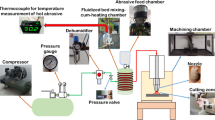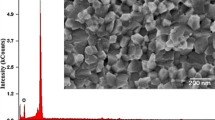Abstract
The better machining capabilities of abrasive jet machining characterized by the absence of thermal distortion make it highly competitive with other cutting processes employing plasma and lasers. In this article, an attempt has been made to combine hot abrasives and compressed air to form a hot abrasive air jet. Hot abrasive jet machining (HAJM) can be applied to various operations such as drilling, surface etching, grooving and micro finishing on the glass and ceramics. This research work involved in cutting performance evaluation of hot abrasive jet machining (HAJM) process and machinability investigation of hardstone quartz concerning surface roughness, taper angle, and material removal rate. Three levels each for air pressure, stand-off distance, and abrasive temperature were selected as control parameters. Experimental results in accordance of Box-Behnken’s design of experiments are analyzed by employing analysis of variance (ANOVA) and statistical technique (here, desirability function analysis of RSM) followed by computational approach (here, genetic algorithm) for experimental investigation, predictive modeling, and multi-response optimization, respectively. Additionally, the effectiveness of proposed two multi-objective optimization techniques are evaluated by confirmation test. Thereafter, the mechanism of material removal has been discussed using a non-contact three-dimensional surface measurement system and scanning electron microscopy images. Finally, a novel approach has been proposed for cost saving economic analysis and sustainability assessment in order to rationalize the operational feasibility and usefulness of hot abrasives in AJM process with an intention to raise the awareness in the manufacturing industry. Analysis of experimental findings revealed that, application of hot abrasives in AJM process have shown an attention in enhancing the cutting performance for material removal. The statistical evaluation and optimization results in this study can contribute to the evaluation of HAJM machinability of hardstone quartz.
Similar content being viewed by others
References
Trivedi P, Dhanawade A, Kumar S (2015) An experimental investigation on cutting performance of abrasive water jet machining of austenite steel (AISI 316L). Adv Mater Process Tech 1(3–4):263–274
Soni H, Narendranath S, Ramesh MR (2018) Effects of wire electro-discharge machining process parameters on the machined surface of Ti50Ni49Co1 shape memory alloy. Silicon 11:733–739
Rahul DS, Masanta M (2018) Surface integrity and metallurgical characteristics of the EDMed work surfaces of A2 tool steel (SAE 304SS), Inconel 601 and Ti-6Al-4V: A comparative analysis. Silicon 10(4):1557–1572
Sasikumar K, Arulshri K, Ponappa K, Uthayakumar M (2016) A study on kerf characteristics of hybrid aluminium 7075 metal matrix composites machined using abrasive water jet machining technology. Proc Inst Mech Eng B J Eng Manuf 232(4):690–704
Kumaran ST, Ko TJ, Uthayakumar M, Islam MM (2017) Prediction of surface roughness in abrasive water jet machining of CFRP composites using regression analysis. J Alloys Compd 724:1037–1045
Naresh Babu M, Muthukrishnan N (2014) Investigation on surface roughness in abrasive water-jet machining by the response surface method. Mater Manuf Process 29(11–12):1422–1428
Zohourkari I, Zohoor M, Annoni M (2014) Investigation of the effects of machining parameters on material removal rate in abrasive Waterjet turning. Adv Mech Eng 6:624203
Jagadish S, Bhowmik S, Ray A (2016) Prediction and optimization of process parameters of green composites in AWJM process using response surface methodology. Int J Adv Manuf Technol 87(5–8):1359–1370
Ming Ming IW, Azmi AI, Chuan LC, Mansor AF (2017) Experimental study and empirical analyses of abrasive waterjet machining for hybrid carbon/glass fiber-reinforced composites for improved surface quality. Int J Adv Manuf Technol 95(9–12):3809–3822
P. A. Dumbhare, Dubey, S., Y. V. Deshpande, Andhare, A. B., & Barve, P. S. (2018). Modelling and multi-objective optimization of surface roughness and kerf taper angle in abrasive water jet machining of steel. J Braz Soc Mech Sci Eng, 40(5). https://doi.org/10.1007/s40430-018-1186-5
Aydin G, Karakurt I, Hamzacebi C (2014) Artificial neural network and regression models for performance prediction of abrasive waterjet in rock cutting. Int J Adv Manuf Technol 75(9–12):1321–1330
Abdelnasser, E. S., Elkaseer, A., & Nassef, A. (2016). Abrasive jet machining of glass: experimental investigation with artificial neural network modelling and genetic algorithm optimisation. Cogent Eng, 3(1). https://doi.org/10.1080/23311916.2016.1276513
Nassef A, Elkaseer A, Abdelnasser ES, Negm M, Qudeiri JA (2018) Abrasive jet drilling of glass sheets: effect and optimisation of process parameters on kerf taper. Adv Mech Eng 10(1):168781401774843
Srinath Reddy, N., Tirumala, D., Gajjela, R., & Das, R. (2018). ANN and RSM approach for modelling and multi objective optimization of abrasive water jet machining process. Decision Sci Lett, 535–548. https://doi.org/10.5267/j.dsl.2017.11.003
Ke J-H, Tsai F-C, Hung J-C, Yang T-Y, Yan BH (2011) Scrap wafer regeneration by precise abrasive jet machining with novel composite abrasive for design of experiments. Proc Inst Mech Eng B J Eng Manuf 225(6):881–890
Kechagias J, Petropoulos G, Vaxevanidis N (2011) Application of Taguchi design for quality characterization of abrasive water jet machining of TRIP sheet steels. Int J Adv Manuf Technol 62(5–8):635–643
Srikanth DV, Rao MS (2015) Application of Taguchi & Response Surface methodology in optimization for machining of ceramics with abrasive jet machining. Mater Today: Proceedings 2(4–5):3308–3317
Nagendra Prasad K, John Basha D, Varaprasad KC (2017) Experimental investigation and analysis of process parameters in abrasive jet machining of Ti-6Al-4V alloy using Taguchi method. Mater Today: Proceedings 4(10):10894–10903
Muthuramalingam T, Vasanth S, Vinothkumar P, Geethapriyan T, Rabik MM (2018) Multi criteria decision making of abrasive flow oriented process parameters in abrasive water jet machining using Taguchi–DEAR methodology. Silicon 10(5):2015–2021
Routara BC, Nanda BK, Sahoo AK, Thatoi DN, Nayak BB (2011) Optimisation of multiple performance characteristics in abrasive jet machining using grey relational analysis. Int J Manufact Techn Manag 24(1/2/3/4):4
Santhanakumar M, Adalarasan R, Rajmohan M (2015) Experimental Modelling and analysis in abrasive Waterjet cutting of ceramic tiles using Grey-based response surface methodology. Arab J Sci Eng 40(11):3299–3311
Tomy A, Hiremath SS (2020) Machining and characterization of multidirectional hybrid silica glass Fiber reinforced composite laminates using abrasive jet machining. Silicon. https://doi.org/10.1007/s12633-020-00504-3
Yue Z, Huang C, Zhu H, Wang J, Yao P, Liu Z (2014) Optimization of machining parameters in the abrasive waterjet turning of alumina ceramic based on the response surface methodology. Int J Adv Manuf Technol 71(9–12):2107–2114
Ibraheem HMA, Iqbal A, Hashemipour M (2014) Numerical optimization of hole making in GFRP composite using abrasive water jet machining process. J Chin Inst Eng 38(1):66–76
Babu MN, Muthukrishnan N (2017) Exploration on Kerf-angle and Surface Roughness in Abrasive Waterjet Machining using Response Surface Method. J Instit Engineers (India): Series C. https://doi.org/10.1007/s40032-017-0366-x
Jagadeesh B, Dinesh Babu P, Nalla Mohamed M, Marimuthu P (2017) Experimental investigation and optimization of abrasive water jet cutting parameters for the improvement of cut quality in carbon fiber reinforced plastic laminates. J Ind Text 48(1):178–200
Kumar A, Singh H, Kumar V (2017) Study the parametric effect of abrasive water jet machining on surface roughness of Inconel 718 using RSM-BBD techniques. Mater Manuf Process 33(13):1483–1490
MM IW, Azmi A, Lee C, Mansor A (2016) Kerf taper and delamination damage minimization of FRP hybrid composites under abrasive water-jet machining. Int J Adv Manuf Technol 94(5–8):1727–1744
Bijeta Nayak B, Abhishek K, Sankar Mahapatra S, Das D (2018) Application of WPCA based Taguchi method for multi-response optimization of abrasive jet machining process. Mater Today: Proc 5(2):5138–5144
Nanda BK, Dhupal D, Buda D, Das SR, S.R. (2018) Abrasive jet Drilling of Alumina Ceramic with pressurized-fluidized bed setup. Mater Today: Proc 5(2):12570–12578
Yuvaraj N, Pradeep Kumar M (2014) Multiresponse optimization of abrasive water jet cutting process parameters using TOPSIS approach. Mater Manuf Process 30(7):882–889
Radovanović M (2016) Multi-objective optimization of process performances when cutting carbon steel with abrasive water jet. Tribol Ind 38(4):454–462
Rao VDP, Mrudula M, Geethika VN (2019) Multi-objective Optimization of Parameters in Abrasive Water Jet Machining of Carbon-Glass Fibre-Reinforced Hybrid Composites. J Instit Engineers (India): Series D. https://doi.org/10.1007/s40033-019-00181-6
Nanda BK, Mishra A, Dhupal D (2016) Fluidized bed abrasive jet machining (FB-AJM) of K-99 alumina ceramic using SiC abrasives. Int J Adv Manuf Technol 90(9–12):3655–3672
Aich U, Banerjee S, Bandyopadhyay A, Das PK (2014) Multi-objective optimisation of abrasive water jet machining responses by simulated annealing and particle swarm. Int J Mechatron Manuf Syst 7(1):38
Wakuda M, Yamauchi Y, Kanzaki S (2002) Effect of workpiece properties on machinability in abrasive jet machining of ceramic materials. Precis Eng 26(2):193–198
Seo YW, Ramulu M, Kim D (2003) Machinability of titanium alloy (Ti’6Al’4V) by abrasive waterjets. Proc Inst Mech Eng B J Eng Manuf 217(12):1709–1721
Uthayakumar M, Khan MA, Kumaran ST, Slota A, Zajac J (2015) Machinability of nickel-based Superalloy by abrasive water jet machining. Mater Manuf Process 31(13):1733–1739
Unde PD, Gayakwad MD, Patil NG, Pawade RS, Thakur DG, Brahmankar PK (2015) Experimental investigations into abrasive Waterjet machining of carbon Fiber reinforced plastic. J Composites 2015:1–9
Klichova D, Klich J (2016) Study of the effect of material machinability on quality of surface created by abrasive water jet. Procedia Eng 149:177–182
Prasad SR, Ravindranath K, Devakumar MLS (2018) Experimental investigation and parametric optimization in abrasive jet machining on nickel 233 alloy using WASPAS and MOORA. Cogent Eng 5(1):1–12
Tomy, A., & Hiremath, S. S. (2019). Machinability and characterisation of machined hole on quartz using developed μ-AJM set-up. Adv Mater Process Tech, 1–16. https://doi.org/10.1080/2374068x.2018.1564868
Madhu S, Balasubramanian M (2018) Impact of nozzle design on surface roughness of abrasive jet machined glass fibre reinforced polymer composites. Silicon 10:2453–2462
Jagannatha N, Somashekhar SH, Sadashivappa K, Arun KV (2012) Machining of soda lime glass using abrasive hot air jet: an experimental study. Mach Sci Technol 16(3):459–472
Wang Z, Li HN, Yu TB, Chen H, Zhao J (2019) On the predictive modelling of machined surface topography in abrasive air jet polishing of quartz glass. Int J Mech Sci 152:1–18
Balamurugan K, Uthayakumar M, Ramakrishna M, Pillai UTS (2019) Air jet Erosion studies on mg/SiC composite. Silicon 12:413–423
Costa NR, Lourenço J, Pereira ZL (2011) Desirability function approach: A review and performance evaluation in adverse conditions. Chemom Intell Lab Syst 107(2):234–244
Ohlsson L (1995) The theory and practice of abrasive water jet cutting. Luleå University of Technology, Sweden
Patel D, Tandon P (2015) Experimental investigations of thermally enhanced abrasive water jet machining of hard-to-machine metals. CIRP J Manuf Sci Technol 10:92–101
Acknowledgements
This work is supported by Research Promotion Scheme for Research Centres under National Doctoral Fellowship of AICTE, India via. Reference no. 8-32/RIFD/RPS-NDF/Policy-1/2018-19.
Author information
Authors and Affiliations
Corresponding author
Ethics declarations
Conflicting of Interest
The authors declare that they have no conflicting of interest.
Additional information
Publisher’s Note
Springer Nature remains neutral with regard to jurisdictional claims in published maps and institutional affiliations.
Rights and permissions
About this article
Cite this article
Pradhan, S., Das, S.R. & Dhupal, D. Performance Evaluation of Recently Developed New Process HAJM during Machining Hardstone Quartz Using Hot Silicon Carbide Abrasives: an Experimental Investigation and Sustainability Assessment. Silicon 13, 2895–2919 (2021). https://doi.org/10.1007/s12633-020-00641-9
Received:
Accepted:
Published:
Issue Date:
DOI: https://doi.org/10.1007/s12633-020-00641-9




